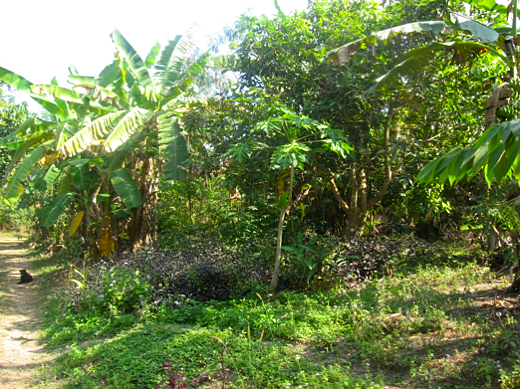 Image above: A tropical food forest in Thailand. From (http://permaculturedesigns.blogspot.com/2009_01_01_archive.html).
Image above: A tropical food forest in Thailand. From (http://permaculturedesigns.blogspot.com/2009_01_01_archive.html).
The drought that is parching the harvest in several of the world’s most productive breadbaskets is the summer’s hottest global food story – and chillingly accompanies the season’s hottest archaeological finding.
Archaeology, by the way, no longer relies on digging for pottery and bones in caves and valleys. It can also use computer-generated climate models, and one of these has allowed desk scientists to break one of the great historical mysteries of the Western hemisphere: the sudden collapse of the Mayan empire of Central America roughly 1,300 years ago.
Turns out, according to U.S. climate modeller Benjamin Cook, that chopping down the region’s forests to grow corn and burn lime to make cement-style blocks for temples caused a drought.
Once the region lost its dark forest canopy, which absorbed the sun’s heat, that heat bounced back into the atmosphere, evaporating the clouds that used to drop the rain needed for an empire entirely dependent on corn.
History seems to be repeating itself for the second of the Western hemisphere’s great empires entirely dependent on a food supply centred around corn and an energy system bent on deforestation.
But what I saw in Honduras last week confirms there is life after plantation-style fields of corn. It just takes a complete rethink of the idea that forests are about wilderness and fields are about food.
So here’s the new paradigm: while green city planners push the notion that urban trees are aesthetic, psychologically calming and good for air quality, they may be only half right. The new appreciation, which looks really old, comes from groups like T.O.’s Not Far from the Tree, which views trees not just as a way to relate to nature but as actual food security providers.
I saw evidence of the proposition that a tree can produce as much food as a small garden in the mountain ranges around Yorito, Honduras.
If Yorito, a two-hour drive north of the capital, gets on the tourist map for forest gardens, it will be the town’s first exposure to the wider world. The nearby mountain villages I visited are another two-hour lurching jeep drive over rib-crunching dirt and gravel roads. (Note to self: never berate high-quality country roads again.)
In Yorito I meet one of the town’s leading micro-entrepreneurs, Nelba Velasquez, who offers us and other visitors excellent meals in her living room restaurant, much of the food from her quarter-acre forest garden.
The first thing I notice in that garden is that the temperature drops about 5 degrees, not just from the shade of the trees but also the from the evaporation of cool water from broadleaf trees. Here, in one overgrown parcel of land, is a beautiful and scrumptious answer to climate chaos, hunger and the chronic-disease pandemic created by deficiencies of micronutrients suffered by rich and poor alike.
Here is my count of what fits in her backyard besides a hammock, a clothesline, a baking oven for bread, a catchment basin for rainwater, two heaps of Japanese-style super-powered compost called bokachi, a woodpile, a raised-bed vegetable garden and a showroom for landscape plants: four avocado trees, two specimens of two different kinds of guava trees, a papaya tree, a mandarin orange and a lemon tree, a tree bearing yellow Nanci berries for juice, a plum tree, 60 coffee plants, a tamarind and an allspice tree.
Did I almost forget to mention 10 varieties of banana?
The entire garden is organic and requires no ploughing, which keeps all the carbon stored by trees and in the soil intact, a powerful measure to mitigate global warming.
Velasquez attributes this diversity to a personality quirk. “I always want to diversify everything. My hands are in everything,” she says.
She’s also on the local public health board and is treasurer of her local “cial” (farmer research team), which promotes seed diversity as a tool of empowerment for low-income communities. Forest gardens and fruit trees sprout among the hilltops dominated by beans and corn wherever cial chapters flourish.
This kind of growing is, I believe, also the next big thing in North America’s local food movement. Seattle claims to have done it first. The folks in Toronto tending the apples, plums, apricots and sweet cherries in the Ben Nobleman Community Orchard are on the same page. And viewing trees as food sources adds a distinct value and puts a new spin, and new responsibility, on Toronto’s poorly funded tree-planting programs.
As my solar engineer friend Greg Allen likes to say, we don’t need a prophet to lead us out of the wilderness; we need a prophet to lead us back to the wilderness.
.
No comments :
Post a Comment